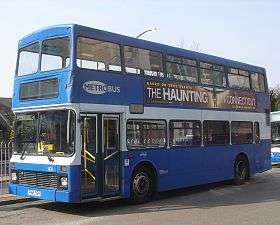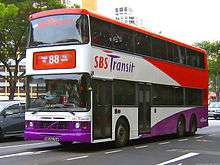Volvo Olympian
| Volvo Olympian | |
|---|---|
 | |
| Overview | |
| Manufacturer | Volvo |
| Production | 1992–2000 |
| Assembly | Irvine |
| Body and chassis | |
| Doors | 1, 2, or 3 |
| Floor type | Step entrance |
| Powertrain | |
| Engine |
Cummins L10 Volvo TD102KF Volvo D10A |
| Power output |
245 hp (Volvo) 215/252 hp (Cummins) |
| Transmission |
Voith DIWA ZF Ecomat |
| Dimensions | |
| Length |
2-axle: 9.6 m, 10.3 m 3-axle: 10.4 m, 11.3 m, 12 m |
| Chronology | |
| Predecessor | Leyland Olympian |
| Successor |
Volvo B7TL (2-Axle) Volvo B10TL Super Olympian (3-Axle) |
The Volvo Olympian was a rear-engined 2-axle and 3-axle double decker bus chassis manufactured by Volvo at its Irvine, Scotland factory. The first was built in 1992 and entered production in March 1993, replacing the Leyland Olympian.
History
The design was based on its predecessor, the Leyland Olympian, but the chassis was modified such that only the chassis design and layout remained, with even the grade of steel for the chassis members being changed, Volvo's standard electrical system was used, as well as standard Volvo steering/"Z cam" braking systems. The early Volvo Olympians were offered with Cummins L10 or Volvo TD102KF engine, coupled to Voith DIWA or ZF Ecomat gearbox.[1][2] From late 1996, only the Volvo D10A-245 Euro II engine with electronic diesel control was offered.
It was available with Alexander R-type, Northern Counties Palatine and East Lancs E Type/Pyoneer bodywork. The Volvo Olympian is likely to be built as either closed top or open top.
The Volvo Olympian remained as popular as the Leyland Olympian in the United Kingdom and Ireland. Large number of Olympians were exported to Hong Kong and Singapore; most of them being air-conditioned.
Orders
United Kingdom
The buses were very popular in the United Kingdom that most of them have 2 axles instead of 3 axles.
London United, Metroline, Stagecoach London, London Central, London General, Capital Citybus, MTL London, Harris Bus and First CentreWest had received 687 Volvo Olympians between 1994 and 1999. Because of a low-floor rule that had to be complied with by 2006, these buses had a short time use. Only two buses from London United survived for rail replacement services.
Many other operators outside London do receive Volvo Olympians.
Ireland
.jpg)

Dublin Bus had continued their orders with the RA batch being ordered first (RA176 - RA325), 150 buses in 1994. In January 1997, Dublin Bus ordered further 315 Volvo Olympians, which is RV. During the period, new liveries had been introduced, of which it is CitySwift and the changing of the livery from two-tone green/orange to white/blue/orange. All buses were withdrawn in 2011.
Hong Kong
Kowloon Motor Bus had ordered 531 Volvo Olympian 11m, 338 Volvo Olympian 12m and 30 Volvo Olympian non-aircon buses between 1994 and 1999. Long Win sold 10 12-metre Volvo Olympians to KMB in 1999. Due to the modernisation of the fleet, all Volvo Olympians have been withdrawn.
Citybus had ordered 10 Volvo Olympian 10.4m, 2 Volvo Olympian 12m (second hand from China Light & Power), 310 Volvo Olympian 12m and 142 Volvo Olympian 11m (two second-hand from China Motor Bus) between 1994 and 1998. Due to the modernisation of the fleet, most of the buses were either withdrawn, sold or converted to training buses.
China Motor Bus ordered 64 Volvo Olympians between 1996 and 1998. 62 were sold to New World First Bus in 1998 and 5 of them were converted to open-top for Rickshaw Sightseeing Bus. New World First Bus received 2 12-metre Volvo Olympians from HACTL in 1999 and 10 from Citybus in 2014. All buses were withdrawn as they aged 16 – 17 years, and the last batch of buses were withdrawn in October 2015.
Singapore

Singapore Bus Services had ordered 100 Volvo Olympian 2-Axles and 201 Volvo Olympian 3-Axles in 1993. The Volvo Olympian 3-Axles (Batch 1) has been delivered between June 1994 and June 1995. These buses were extended to 2 years in 2011, and some to 6 months/permanent 1 year extension in 2013 - 2014. About 7 buses were retired before June 2013. 29 buses were extended to 1 year to facilitate retirement of Volvo Olympian 3-Axle (Batch 2) as well as to facilitate deployment of Volvo B9TLs on Jurong Industrial services after all the buses were retired.
It thus followed by 200 Volvo Olympian 3-Axles again in 1995 and lastly 70 Volvo Olympian 3-Axles in 1998.
The Volvo Olympian 2-Axles are the last Non-Air Conditioned Buses to be brought by Singapore Bus Services, but were unable to convert to air-conditioned because of the heavy weight and follows their partners but charges lower fares. In 2003, some of the Volvo Olympian 2-Axles went over to Soon Lee Bus Park (SLBP), and shared with the older Leyland Olympian 3-Axles (Air-Con) buses to replace the de-registered Leyland Olympian 2-Axles, which is already being replaced by June 2004. In July 2004, only 246 and 251 became non air-con until the Volvo Olympians were transferred over in 2009. All the Volvo Olympian 2-Axles were withdrawn between June 2011 and September 2013.
Later in 1996 - 1998 they were given another 200 Volvo Olympian 3-Axle (Batch 2) to replace all the retirement of Mercedes-Benz O305 and they were given another 2 years lifespan because of insufficient deliveries of buses. The Volvo Olympian 3-Axle Batch 2 will be the last one to use plastic destination displays.
In addition, they installed LECIP EDSes to Batch 3 Volvo Olympian 3-Axles to distinguishable to other batches. The deregistration starts in 2016, but it will still be extended with another 6 months - 2 years lifespan because of insufficient deliveries of buses and complaints. At present SBS9603C, SBS9605Y, SBS9610G and SBS9614X were extended. All buses have their seats removed for wider standing space. The Volvo Olympians were the last double deckers to have steps before the revolution of wheelchair-accessible bus services began with 502, 21, 25, 28, 72, 147, C1, C2 and C3.
End of production
Production of Volvo Olympian ended in 2000 and concluded a run of over 10,000 Leyland/Volvo Olympian chassis. The last built were for Yorkshire Coastliner and had Alexander Royale bodies. The chassis had two low-floor successors: the 2-axle Volvo B7TL and the 3-axle Volvo Super Olympian.
References
- ↑ Volvo power for Olympian Commercial Motor 27 February 1992
- ↑ Volvo opens bus lines in Irvine Commercial Motor 1 April 1993
External links
 Media related to Volvo Olympian at Wikimedia Commons
Media related to Volvo Olympian at Wikimedia Commons- Flickr gallery